Trees Birds Mammals Fish Amphibians Reptiles
Wild Algarve
Bookshop
Atyheniella adonis (Bull.) Redhead et al. - Scarlet Bonnet
Phylum: Basidiomycota - Class: Agaricomycetes - Order: Agaricales - Family: Porotheleaceae
Distribution - Taxonomic History - Etymology - Identification - Culinary Notes - Reference Sources
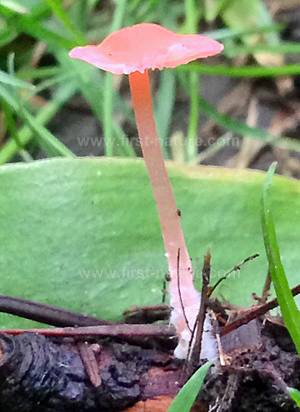
One of the most beautiful, and unfortunately also one of the less common, of woodland mushrooms, the Scarlet Bonnet Atheniella adonis (until recently generally referred to as Mycena adonis) is very small and can easily be missed. Indeed, when considering the distinctive red-stemmed variety shown here some of us have consistently missed out on finding this rarity despite decades of woodland foraying!
Look out for these pretty little mushrooms in damp coniferous and mixed woodlands. As with other mushrooms of this kind you can expect to find them in areas of deep shade, where in the case of Scarlet Bonnets they grow attached either to small dead twigs or to other woody debris buried in the top layer of needle and leaf litter.
Most of the Mycena species have dull-coloured caps, and it may be that this lovely coral-red mushroom and a few other small and brightly-coloured bonnet fungi in the genus Atheniella are only distantly related to the other, often duller bonnet mushrooms that are currently - Classified in the genus Mycena.
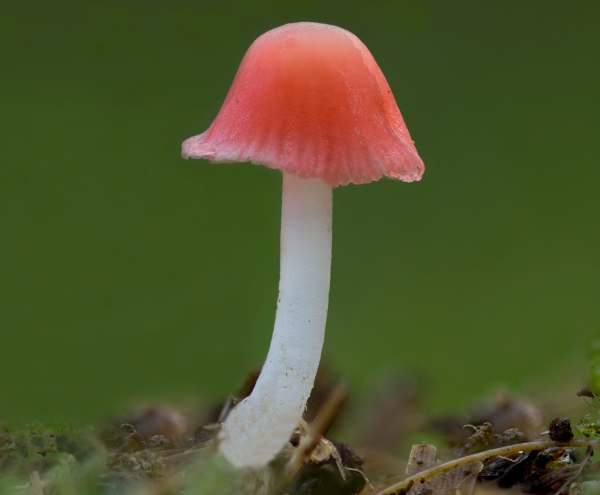
The tiny Scarlet Bonnet mushrooms shown above are a mere 2 to 3mm across.
Distribution
In Britain and Ireland the Scarlet Bonnet is an uncommon find, and the pink-stemmed variety Atheniella adonis var. coccinea is very rarely seen, although both varieties are recorded in England, Wales and Scotland. To date var. coccinea has not been formally recorded in Ireland, but the likelihood is that it does occur there. Atheniella adonis is found, although infrequently, throughout mainland Europe and much of Asia, and it is also recorded in North America.
Taxonomic history
Beautiful mushrooms attract a lot of scientific attention, and bright red ones particularly so. French mycologist Jean Baptiste Francois (Pierre) Bulliard described the Scarlet Bonnet mushroom in 1792, giving it the binomial scientific name Agaricus adonis. (Most of the gilled mushrooms were included initially in the genus Agaricus!) In 1799 English naturalist James Sowerby (1757 - 1822) described the red-stemmed form of this mushroom as Agaricus coccineus, and in 1938 German mycologist Robert Kühner (1903 - 1996) recognised this mushroom as Mycena adonis var. coccinea. As a result the nominate variety had to be be formally referred to as Mycena adonis var. adonis. (It is impossible to create just one 'variety' name; automatically the original species is also given a var. name too.) British botanist and mycologist Samuel Frederick Gray is credited with establishing the scientific name as Mycena adonis in an 1821 publication, but now its generally accepted scientific name is Atheniella adonis, following a 2012 publication by Canadian mycologists Redhead, Moncalvo, Vilgalys and Perry.
Synonyms of Atheniella adonis include Mycena adonis (Bull.) Gray, Agaricus adonis Bull., Agaricus floridulus Fr., Collybia floridula (Fr.) Gillet, Mycena floridula (Fr.) Quél., Mycena rubella Quél., Hemimycena adonis (Bull.) Singer and Marasmiellus floridulus (Fr.) Singer.
Etymology
The specific epithet adonis is a reference to the beauty of this mushroom, which is named after the (male) Greek God of Beauty. In Greek mythology Adonis had youthful good looks that won the hearts of the goddesses Aphrodite and Persephone. Adonis is also associated with the rebirth of flowers, which emerge fresh and young again each year - as of course does the Scarlet Bonnet mushroom!
Identification guide
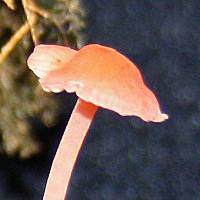 |
Cap
1 to 1.5cm across; conical, becoming bell shaped and then broadly umbonate; smooth, displaying marginal lines half-way to the cap centre when wet; reddish or deep pink, often a lighter shade towards the rim.
The cap flesh is pinkish. |
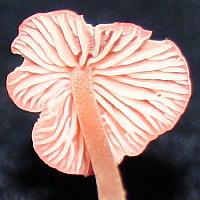 |
Gills
Adnate or adnexed, fairly distant; white tinged with pink
Stem
Cylindrical, hollow, with fine longitudinal fibres (pruinose when very young); 1.5 to 3cm long and 0.5 to 1.5mm in diameter; whitish in var. adonis but deep pink in var. coccinea (as shown here); no stem ring. |
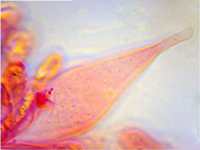 |
Pleurocystidia and Cheilocystidia
Abundant; typically 50µm long and 12µm across at the broadest point; fusiform, smooth, terminating in a needle-like neck which sometimes is branched.
|
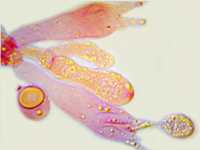 |
Basidia
Two-spored (shown here) and four-spored forms occur. (Spores from two-spored basidia are larger than those from four-spored basidia.)
|
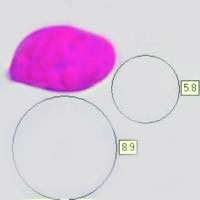 |
Spores
Ellipsoidal to pip-shaped, smooth, 6.5-9 x 4.5-6µm; inamyloid. (Shown on the left are spores from two-spored basidia.)
Spore print
White. |
Odour/taste |
Not distinctive. |
Habitat & Ecological role |
Saprobic; occurring as singletons or small scattered groups in woody debris in coniferous and mixed woodlands. Also occasionally found with Sphagnum moss in peat bogs. |
Season |
Mostly June to October in Britain and Ireland. |
Similar species |
Mycena acicula, known as the Orange Bonnet, is also very small and can occur in similar habitats. As the name suggests it has a more orange cap; its spores are fusiform rather than ellipsoidal. |
|
Culinary notes
These little fungi are far too small and insubstantial to be of culinary interest. It is unclear whether they are toxic or not.
Reference Sources
Fascinated by Fungi, 2nd Edition, Pat O'Reilly 2016, reprinted by Coch-y-bonddu Books in 2022.
Giovanni Robich, (2003). Mycena d'Europa; Associazione Micologica Bresadola ; Vicenza : Fondazione Centro Studi Micologici.
Dictionary of the Fungi; Paul M. Kirk, Paul F. Cannon, David W. Minter and J. A. Stalpers; CABI, 2008
Taxonomic history and synonym information on these pages is drawn from many sources but in particular from the British Mycological Society's GB Checklist of Fungi.
Acknowledgements
This page includes pictures kindly contributed by Simon Harding.
Top of page...
Fascinated by Fungi. Back by popular demand, Pat O'Reilly's best-selling 450-page hardback book is available now. The latest second edition was republished with a sparkling new cover design in September 2022 by Coch-y-Bonddu Books. Full details and copies are available from the publisher's online bookshop...